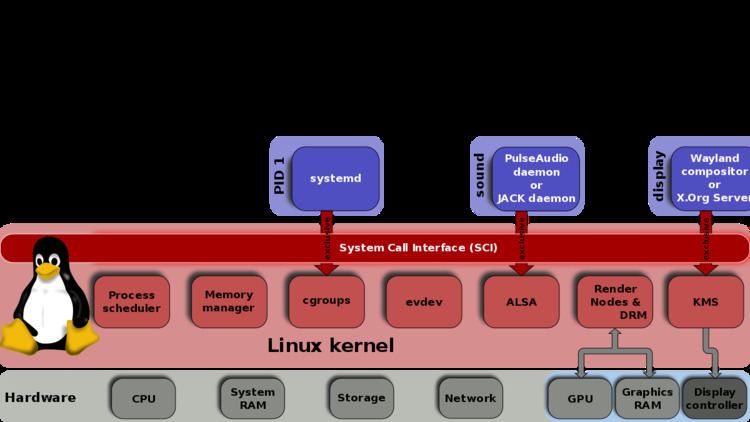Written in C | Operating system | |
 | ||
Original author(s) Developer(s) kernel.org (Tejun Heo et al.) and freedesktop.org Initial release 2007; 10 years ago (2007) | ||
cgroups (abbreviated from control groups) is a Linux kernel feature that limits, accounts for, and isolates the resource usage (CPU, memory, disk I/O, network, etc.) of a collection of processes.
Contents
- Versions
- Features
- Use
- Redesign
- Namespace isolation
- Unified hierarchy
- Kernel memory control groups kmemcg
- Adoption
- References
Engineers at Google (primarily Paul Menage and Rohit Seth) started the work on this feature in 2006 under the name "process containers". In late 2007, the nomenclature changed to "control groups" to avoid confusion caused by multiple meanings of the term "container" in the Linux kernel context, and the control groups functionality was merged into the Linux kernel mainline in kernel version 2.6.24, which was released in January 2008. Since then, developers have added many new features and controllers, such as support for kernfs, firewalling, and unified hierarchy.
Versions
There are two versions of cgroups.
Cgroups was originally written by Paul Menage et al. and mainlined into the Linux kernel in 2007. Afterwards this is called cgroups version 1.
Then development and maintenance of cgroups was taken over by Tejun Heo. Tejun Heo redesigned and rewrote cgroups. This rewrite is now called version 2, the documentation of cgroups-v2 first appeared in Linux kernel 4.5 released on March 14, 2016.
Unlike v1, cgroup v2 has only a single process hierarchy and discriminates between processes, not threads.
Features
One of the design goals of cgroups is to provide a unified interface to many different use cases, from controlling single processes (by using nice, for example) to whole operating system-level virtualization (as provided by OpenVZ, Linux-VServer or LXC, for example). Cgroups provides:
Use
A control group (abbreviated as cgroup) is a collection of processes that are bound by the same criteria and associated with a set of parameters or limits. These groups can be hierarchical, meaning that each group inherits limits from its parent group. The kernel provides access to multiple controllers (also called subsystems) through the cgroup interface; for example, the "memory" controller limits memory use, "cpuacct" accounts CPU usage, etc.
Control groups can be used in multiple ways:
The Linux kernel documentation contains full technical details of the setup and use of control groups.
Redesign
Redesign of cgroups started in 2013, with additional changes brought by versions 3.15 and 3.16 of the Linux kernel.
Namespace isolation
While not technically part of the cgroups work, a related feature of the Linux kernel is namespace isolation, where groups of processes are separated such that they cannot "see" resources in other groups. For example, a PID namespace provides a separate enumeration of process identifiers within each namespace. Also available are mount, UTS, network and SysV IPC namespaces.
Namespaces are created with the "unshare" command or syscall, or as new flags in a "clone" syscall.
The "ns" subsystem was added early in cgroups development to integrate namespaces and control groups. If the "ns" cgroup was mounted, each namespace would also create a new group in the cgroup hierarchy. This was an experiment that was later judged to be a poor fit for the cgroups API, and removed from the kernel.
Linux namespaces were inspired by the more general namespace functionality used heavily throughout Plan 9 from Bell Labs.
Unified hierarchy
Whenever designing software, a software engineer seeks solutions which overall best address exigencies regarding stability, security, performance, as well as maintainability, programmability (API) and usability (ABI). By their nature, these exigencies balance each other, e.g., a mighty API to user space, that doesn't offer too much functionality, but carelessly exposes some key inner working, might seriously compromise stability and security. That is especially true if that software is part of the Linux kernel.
Tejun Heo decided to alter cgroups to prevent these scenarios, designing and implementing a unified hierarchy with only one user space entity that has exclusive access to the facilities offered by cgroups.
Kernfs was introduced into the Linux kernel with version 3.14, the main author being Tejun Heo. One of the main motivators for a separate kernfs is the cgroups file system. Kernfs is basically created by splitting off some of the sysfs logic into an independent entity so that other kernel subsystems can more easily implement their own virtual file system with handling for device connect and disconnect, dynamic creation and removal as needed or unneeded, and other attributes. Redesign continued into version 3.15 of the Linux kernel.
Kernel memory control groups (kmemcg)
Kernel memory control groups (kmemcg) were merged into version 3.8 of the Linux kernel mainline. The kmemcg controller can limit the amount of memory that the kernel can utilize to manage its own internal processes.
Adoption
Various projects use cgroups as their basis, including CoreOS, Docker, Hadoop, Jelastic, Kubernetes, lmctfy (Let Me Contain That For You), LXC (LinuX Containers), systemd, Mesos and Mesosphere, HTCondor.
